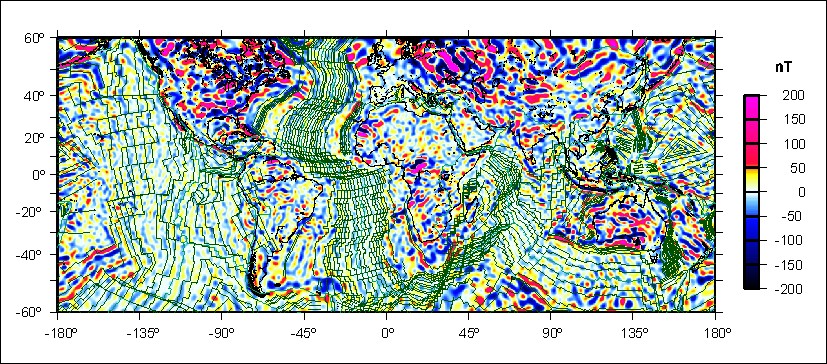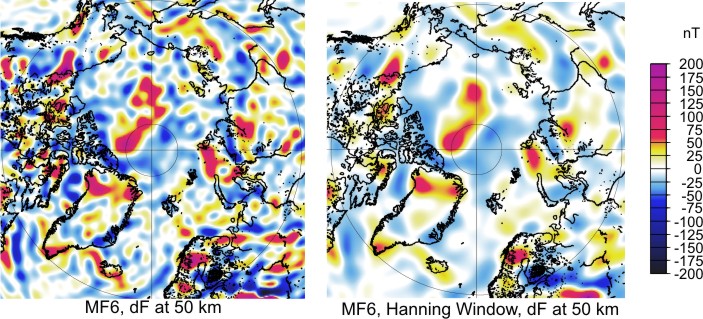| |
Geomagnetism |
|
| Home | Magnetic Field Overview | Model and software downloads | Online Calculators | Magnetic Data Sources | Geomagnetic Tutorials |
|---|
|
|||

|
|||
Fig.1: (click to enlarge) Fig. 1: Vertical component of the MF6 crustal magnetic field at the Earth surface, overlain with the isochrons of an ocean-age model inferred from independent marine and aeromagnetic data by Muller et al. (2007) and plate boundaries by Bird (2003). |
|||
|
A cautionary note on "ringing" in satellite crustal maps: |
To completely get rid of the bubbliness one can apply a Hanning Window in the wavenumber domain, but at the cost of a significant loss in small-scale features (see Figure 2). As a general recommendation, one should use the un-fitered version (sharp cutoff) when substituting a long wavelength satellite model into a regional magnetic compilation of marine or aeromagnetic measurements, and the Hanning-windowed version when displaying the satellite model stand-alone. The table of products below includes Hanning-filtered versions of the grids of the anomaly of the total intensity at ellipsoid and 50 km altitude. |

|
| Fig.2: (click to enlarge) Fig. 2: Demonstration of the effect of the Hanning window. The left image shows the anomaly of the total intensity (dT) at 50 km altitude as given by MF6 with a sharp cutoff in the degree-band 120-130. The right image shows the result after applying a Hanning window to the MF6 spherical harmonic coefficients. |
| Available MF6 Downloads | ||||||
|---|---|---|---|---|---|---|
| Type | Format | Mbyte | Ref. Radius | Contents | ||
|
|
SH coefficients | ASCII Table | 0.2 | 6371.2 km |
MF6
Model spherical harmonic coefficients (Schmid semi-normalized, as usual) |
|
|
|
Poster | 13 | WGS84 | MF6 model poster at AGU conference, San Francisco, 2007 | ||
|
|
Article | 4.8 | Sixth generation lithospheric magnetic field model from CHAMP satellite magnetic measurements | |||
|
|
Graphic | 1.7 | WGS84 | Image of vertical component (Z) at WGS84 ellipsoid altitude. | ||
|
|
Listing | ZIP | 42 | WGS84 |
MF6_Z_0.xyz.gz 6 arc minute ascii grid of vertical component (Z) at WGS84 ellipsoid altitude. |
|
|
|
Graphic | 1.8 | WGS84 | Image of the anomaly of total intensity at WGS84 ellipsoid altitude. | ||
|
|
Listing | ZIP | 6 | WGS84 |
MF6_dT_0.xyz.gz 15 arc minute ascii grid of the anomaly of total intensity at WGS84 ellipsoid altitude. |
|
|
|
Listing | ZIP | 24 | WGS84 |
MF6_dT_0_Hanning.xyz.gz 7.5 arc minute ascii grid of the anomaly of total intensity at WGS84 ellipsoid altitude, after applying a Hanning window to the MF6 coefficients. |
|
|
|
Listing | ZIP | 24 | WGS84 + 50 km |
MF6_dT_50.xyz.gz 7.5 arc minute ascii grid of the anomaly of total intensity at 50 km altitude above the WGS84 ellipsoid. |
|
|
|
Listing | ZIP | 24 | WGS84 + 50 km |
MF6_dT_50_Hanning.xyz.gz 7.5 arc minute ascii grid of the anomaly of total intensity at 50 km altitude above the WGS84 ellipsoid, after applying a Hanning window to the MF6 coefficients. |
|
|
|
Graphic | 1.5 | WGS84 + 350 km | Image of the anomaly of total intensity at 350 km altitude. | ||
|
|
Listing | ZIP | 4 | WGS84 + 350 km |
MF6_dT_350.xyz.gz 15 arc minute ascii grid of the anomaly of total intensity at 350 km altitude. |
|
|
|
Video | MPEG | 50 | WGS84 + 50 km |
MF6_Z_50.mpg Rotating globe animation of the vertical component of the crustal field at 50 km altitude. |
|
2009-Oct-24, Stefan Maus